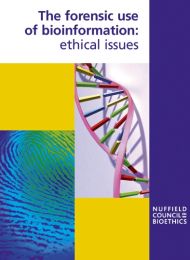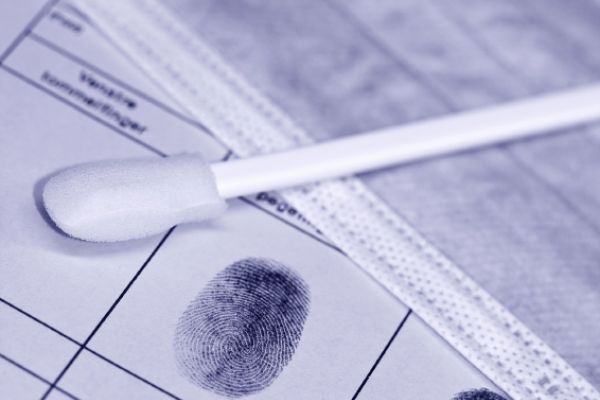The forensic use of bioinformation: ethical issues
Report
Published 19/09/2007

Taking fingerprints and DNA
Fingerprints and DNA samples may be taken by the police, without consent, from anyone arrested for a ‘recordable’ offence (mostly offences that can lead to a prison sentence). These can be checked against the National DNA Database and the fingerprint database (called IDENT1) to help the police identify suspects for unsolved crimes.
In 2007, the Government consulted on proposals to extend police powers to allow them to take DNA without consent from people arrested for ‘non-recordable’ offences, which include minor offences such as littering and minor traffic offences. We recommend that these proposals should not be implemented.
We conclude
It is proportionate for the police to take fingerprints and DNA without the need for consent from people arrested on suspicion of involvement in any recordable offence, but not minor non-recordable offences.
Storing fingerprints and DNA
At present in England and Wales (but not Scotland) fingerprints and DNA taken from anyone arrested for a ‘recordable’ offence can be retained indefinitely without their consent, regardless of the outcome of the case.
The number of profiles on the DNA Database has doubled in recent years, yet the number of crimes solved where DNA evidence played a role has stayed more or less the same. It has been suggested that this is because the people now being added to the Database are unlikely to commit the type of crimes for which DNA evidence is relevant.
There is a lack of convincing evidence that retention of profiles of those not charged or convicted has had a significant impact on detection rates and hence it is difficult to argue that such retention would be justified and proportionate.
We conclude
Fingerprints, biological samples and DNA profiles should be retained indefinitely only for those convicted of a recordable offence. This would bring the law in England, Wales and Northern Ireland into line with that in Scotland. The exception would be the DNA of people charged with serious violent or sexual offences, which could be kept for up to five years even if they are not convicted.
Victims, witnesses and volunteers
Biological samples and DNA profiles can only be taken and retained from witnesses, victims and volunteers (e.g. people who volunteer to take part in mass intelligence screens) if they give their consent. However, once consent is given, it cannot be later withdrawn. This approach is contrary to standard practice in medical research, and differs from practice in Scotland and many other European countries.
We conclude
Volunteers should be able to have their DNA removed from the National DNA Database at any time without having to give a reason. Ideally, volunteers’ DNA should not be stored at all beyond the conclusion of the relevant case.
Minority ethnic groups on the National DNA Database
Young black males are over-represented on the National DNA Database. One third of young black males are on the Database whereas the proportion is one eighth for young white males. Policing practices may have led to the disproportionate arrest of certain ethnic groups, and therefore their over-representation on the Database compared with their rates of conviction.
We conclude
We welcome the ‘equality impact assessment’ of the National DNA Database that has recently been commissioned. This should reveal the extent to which it is the discretionary use of powers of arrest or the use of sampling powers that contributes to over-representation of black ethnic minorities.
Children on the National DNA Database
DNA from young people arrested on suspicion of a crime is retained in the same way as it is for adults, and there are around 750,000 under-18s on the National DNA Database. This may be particularly problematic in the UK, where the age of criminal responsibility is low – ten years in England and Wales and eight in Scotland. It could be argued that retaining bioinformation from young people is contrary to Article 40 of the UN Convention on the Rights of the Child. The Convention requires special attention be given to the treatment of children by legal systems, to protect them from stigma, and that if they have offended, opportunities for rehabilitation should be maximised.
We conclude
When considering requests for the removal from storage of fingerprints and DNA taken from minors, there should be a presumption in favour of the removal and destruction of all records, samples and DNA profiles. In deciding whether or not the presumption should be rebutted, account should be taken of factors such as:
- the seriousness of the offence
- previous arrests
- the outcome of the arrest
- the likelihood of this individual re-offending
- the danger to the public
- any other special circumstances
Crime scene samples
At present, fewer than 20 per cent of crime scenes are forensically examined, and only a small proportion of these produce any biological material that can be tested. In addition, crime scene samples are not currently retained on the Database once the case is closed.
We conclude
Expenditure for crime scene analysis should be given higher priority than the increased collection of subject samples. In addition, samples recovered from crime scenes must be retained indefinitely because they are unique and unrepeatable.
Should there be a population-wide DNA database?
Some believe that taking the DNA of everyone at birth to build a population-wide forensic database would assist the police whilst also removing problems of discrimination. However, this would be hugely expensive, impractical and would have only a small impact on public safety. The intrusion of privacy incurred would therefore be disproportionate to any possible benefits to society.
We conclude
Currently, the balance of argument and evidence presented to us is against the establishment of a population-wide forensic DNA database. However, the possibility of establishing a population-wide database should be subject to review as technology develops.

Share